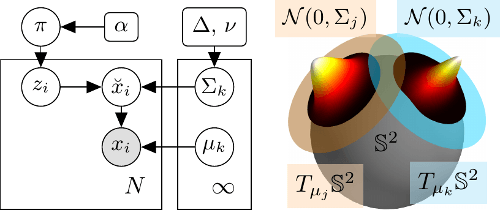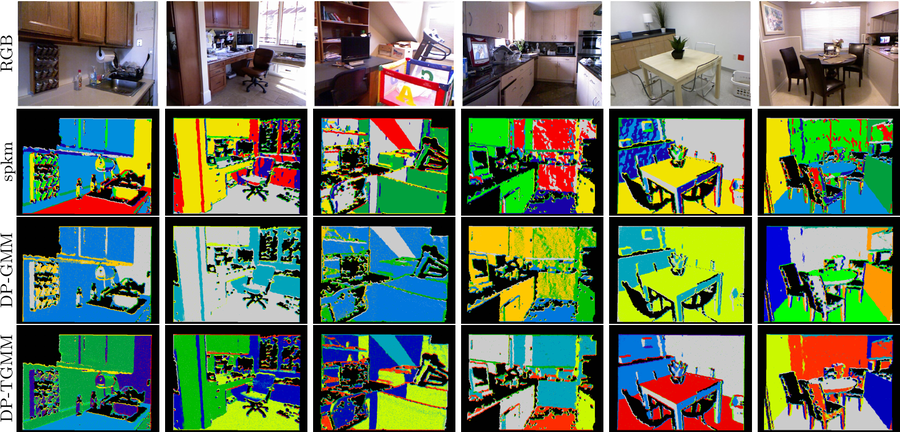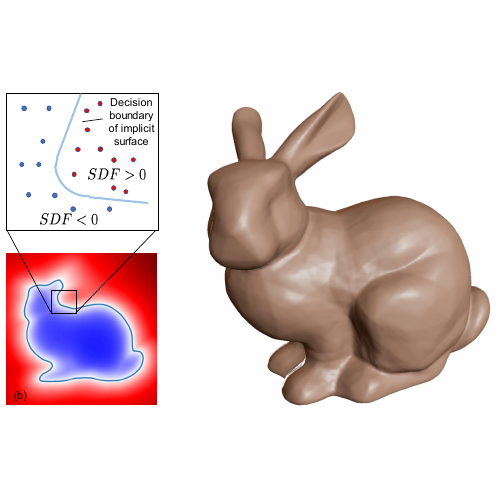A Dirichlet Process Mixture Model for Spherical Data
Directional data, naturally represented as points on the unit sphere, appear in many applications. However, unlike the case of Euclidean data, flexible mixture models on the sphere that can capture correlations, handle an unknown number of components and extend readily to high-dimensional data have yet to be suggested. For this purpose we propose a Dirichlet process mixture model of Gaussian distributions in distinct tangent spaces (DP-TGMM) to the sphere. Importantly, the formulation of the proposed model allows the extension of recent advances in efficient inference for Bayesian nonparametric models to the spherical domain. Experiments on synthetic data as well as real-world 3D surface normal and 20-dimensional semantic word vector data confirm the expressiveness and applicability of the DP-TGMM.

Many applications of interest involve measurements of directional data. In 3D scenes, unit-length surface normals extracted from point clouds reside in a 2D manifold (i.e., the unit sphere in 3D). In biology, protein backbone measurements are described and classified based on their angular configurations in the so-called Ramachandran plots. Directional data also exists outside of the 3D world. E.g., the words counts in a corpus of documents can be viewed as directional data once normalized to have unit 2 norm. Word-frequency vectors are often clustered using the cosine similarity, which measures the cosine of the angle formed by two vectors. This measure essentially treats the word-frequency vectors as directional data, and has been shown to be superior to Euclidean distance for document clustering. Another example of directional data is semantic word vectors, which associate a high-dimensional vector with each word in a given corpus. The semantic word vectors capture the semantic context of the associated words, and should not to be confused with the word-frequency vectors of documents. Again, cosine similarity is used as the distance measure to find words with similar meaning.
One common task in many of these applications is to group the data into similar clusters. Due to the non- linearity of the hyper-sphere, clustering on the spherical manifold is often treated in an ad-hoc manner by either ignoring the geometry of the sphere or using overly-restricted models. In this work, we present a flexible Bayesian nonparametric (BNP) model for data residing on a hyper-sphere that respects the inherent geometry of the manifold. As shown above, our approach draws on the Dirichlet process Gaussian mixture model (DP-GMM), and models full covariance matrices on (linear) tangent spaces to the sphere. Importantly, the covariances of the Gaussians, capturing intra-cluster correlations, have analytical conjugate priors that enable efficient inference. Additionally, the approach transparently scales to high-dimensional data. We extend the efficient inference method of, a parallelized restricted Gibbs sampler with sub-cluster split/merge moves, to account for the geometry of the sphere. Moreover, we show how to combine sufficient statistics from tangent spaces around different points of tangency to propose merges efficiently.
Comparison of different clustering algorithms on synthetic isotropic and anisotropic data

Mean and standard deviation over ten sampler runs of normalized mutual information (NMI) and cluster-count for synthetic datasets of 30 isotropic (top) and anisotropic (bottom) clusters on the unit sphere in 3D. The colors for the different algorithms are consistent across all plots. In the sphere-plots to the right it can be observed that, in contrast to the DP-TGMM, the DP Gaussian mixture model (DP-GMM) fails to separate (top) or incorrectly splits (bottom) clusters. This is a result of the DP-GMM clustering the data in the ambient Euclidean space and not on the spherical manifold. While the spherical k-means (spkm) and the k-means algorithm were both set to the true number of clusters, their clustering performance lacks behind the sampling based methods. The finite symmetric Dirichlet approximation to the DP-TGMM (referred to as FSD-TGMM) gives an incorrect and noisy estimate for the number of clusters and hence motivest the use of the proposed sub-cluster split/merge inference algorithm.
Comparison of different clustering algorithms and models on real-world surface normal data

In the top row we show RGB images of the scene (only) for reference. We visualize the segmentation implied solely by the clustering of normals using the spherical k-means (spkm) algorithm with k = 7 (2nd row), using the DP-GMM (3rd row) and the proposed DP-TGMM (bottom row). Note how spkm and DP-GMM fail to properly segment the scenes. The colors encode the association to inferred clusters and black denotes missing depth data.
Bibtex
@inproceedings{straub2015dptgmm,
author = {Straub, Julian and Chang, Jason and Freifeld, Oren and Fisher III, John W.},
title = {A Dirichlet Process Mixture Model for Spherical Data},
year = {2015},
booktitle = {AISTATS},
url = { http://people.csail.mit.edu/jstraub/download/straub2015dptgmm.pdf}
}


